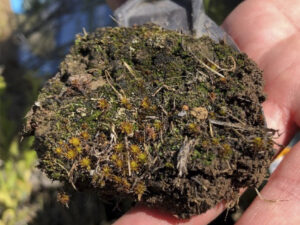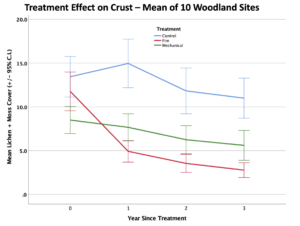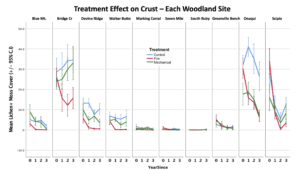Across the globe, biological soil crusts – commonly called biocrusts – aid ecosystem functions like nutrient and hydrologic cycling, soil stabilization and the maintenance of albedo (the amount of light reflected by the earth’s surface). Biocrusts are a mostly photoautotrophic (creates its own food) soil surface community composed of moss, lichen, cyanobacteria, algae, and fungi (fig. 1). Biocrusts occur in all plant communities across arid and semi-arid ecosystems in the western U.S.
 Figure 1. An example of biological crusts from the Great Basin, U.S.A.
Figure 1. An example of biological crusts from the Great Basin, U.S.A.
Across the sagebrush steppe of the Great Basin, biocrusts help to increase the ecosystem’s resistance to invasive species, especially in the presence of fire and grazing. Mosses, lichens, and perennial grasses are associated with reduced cover of cheatgrass (Bromus tectorum L.). Similarly, when looking at both vascular plants and morphological groups of biocrusts along disturbance gradients of fire severity, grazing intensity and invasion by cheatgrass, perennial grasses increase in cover with low to moderate levels of fire severity and grazing intensity. However, morphological groups of biocrusts are abundant along different portions of these disturbance gradients. Some mosses are lost following fire, but are more tolerant of grazing. Losses to the cover of tall mosses (mosses over 1 cm tall) – such as Syntrichia ruralis (Hedw.), F. Weber and D. Mohr – appear to foreshadow the loss of perennial grasses. Lichens are generally sensitive to grazing, but are somewhat tolerant of fire.
There is a growing body of research on active restoration of biocrusts. Dryland mosses have been restored with regular increases in cover of 30 percent a year, and the same methods have been successful in the semi-arid intermountain grasslands of western Montana and the Colorado Plateau. However, successes with the lichen component have been limited to ruderal groups – species that are first to colonize after disturbance such as Cladonia sp., or material that has been lifted from one place and laid down on top of the soil surface in another (also known as salvage efforts). Many ruderal species and groups are present with disturbance or quickly recover following the cessation of disturbance. In these cases, it is not clear if active restoration is necessary or beneficial to ecosystem processes.
The levels of restoration success are dependent on the restoration goal. SageSTEP addresses many common restoration goals across the region, such as recovery of native vegetation, hydrologic function and sagebrush obligate birds. SageSTEP has previously included the response of biocrusts – as a single entity (moss + lichen), to fuel reduction treatments within the sagebrush-cheatgrass and woodland sites, and separately as mosses, lichens and cyanobacteria on the Onaqui woodland site for responses to prescribed fire. The first three years of data from across the woodland sites indicate that mowing treatments are not as detrimental to biocrusts, (moss + lichen), compared with prescribed fire (fig. 2). However, sites level difference indicate that not only did cover of biocrusts vary by site prior to treatment, but the post-treatment responses varied as well (fig. 3). For example, compare the crust response at Bridge Creek v. Onaqui, through three years of time – while both fire and mechanical treatments caused a decrease in crust at Onaqui, only fire had that effect at Bridge Creek. And at Scipio crusts declined in all plots through time. Further work is needed to understand these kinds of site-level differences.
Click on images to get a closer look
Figure 2. Short-term response of biological crust (moss + lichen) to fire and mechanical treatments, averaged over 10 woodland sites (mean +/- 95% confidence intervals).
Figure 3. Short-term response of biological crust (moss + lichen) to fire and mechanical treatments for 10 woodland SageSTEP sites (mean +/- 95% confidence intervals).
The response of biocrusts to fuel reduction treatments sets this interesting and often overlooked vegetative group, as another restoration component to consider if reduced cover of cheatgrass is a management goal.
This field note written by Lea Condon.
More biological soil crust resources-
Bowker MA, Antoninka AJ, Chuckran PF (2019) Improving field success of biocrust rehabilitation materials: hardening the organisms or softening the environment? Restoration Ecology doi.org/10.1111/rec.12965
Condon LA, Pyke DA (2016) Filling the interspace–restoring arid land mosses: source population, organic matter and overwintering govern success. Ecology and Evolution 6, 7623-7632.
Condon LA, Pyke DA (2018a) Fire and grazing influence site resistance to cheatgrass invasion 520 through their effects on shrub, bunchgrass, and biocrust communities. Ecosystems 21, 1416-1431. doi: 521 10.1007/s10021-018-0230-8. 522
Condon LA, Pietrasiak N, Rosentreter R, Pyke DA. (2019) Passive restoration of vegetation and biological soil crusts following 80 years of exclusion from grazing across the Great Basin. Restoration Ecology doi.org:10.1111/rec.13021
Condon LA, Pyke DA (2018b) Resiliency of biological soil crusts and vascular plants varies 523 among morphogroups with disturbance intensity. Plant and Soil 433, 271-287.
Miller RF, Ratchford J, Roundy BA, Tausch RJ, Hulet A, Chambers JC. (2014) Response of conifer-encroached shrublands in the Great Basin to prescribed fire and mechanical treatments. Rangeland Ecology and Management 67(5), 468-481. doi.org/10.2111/REM-D-13-00003.1
Pyke DA, Shaff SE, Lindgren AI, Schupp EW, Doescher PS, Chambers JC, Burnham JS, Huso MM. (2014) Region-wide ecological responses of arid Wyoming big sagebrush communities to fuel treatments. Rangeland Ecology and Management 67(5), 455-467. doi.org/10.2111/REM-D-13-00090.1
Slate ML, Durham RA, Pearson DE. (2019) Strategies for restoring the structure and function of lichen-moss biocrust communities. Restoration Ecology doi:10.1111/rec12996
Warren SD, St. Clair LL, Johansen JR, Kugrens P, Baggett LS, Bird BJ. (2015) Biological soil crust response to late season prescribed fire in a Great Basin juniper woodland. Rangeland Ecology and Management 68, 241-247. doi.org/10.1016/j.rama.2015.03.007
Warren SD, St. Clair LL, Leavitt SD. (2018) Aerobiology and passive restoration of biological soil crusts. Aerobiologia 35, 45-56.


